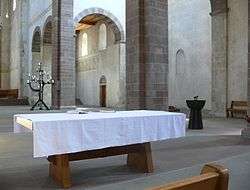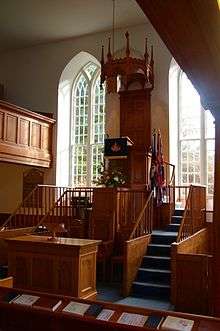Communion table
Communion table or Lord's table are terms used by many Protestant churches—particularly from Reformed, Baptist and low church Anglican and Methodist bodies—for the table used for preparation of Holy Communion (a sacrament also called the Eucharist). These churches usually do not use the term "altar" because they do not see Communion as sacrificial in any way. However, in colloquial speech, the word "altar" is often used interchangeably with "communion table".[1]

Terminology
The use of a simple table, generally built of wood, instead of an altar made of stone reflects these churches' rejection of the suggestion of sacrifice in the rite: they believe that the Passion of Jesus Christ was a perfect sacrifice for sins made once for all (Hebrews 9:25-10:4).
Many Protestant churches that choose not to use the term "altar" may still have an "altar call", in which visitors wish to make a new spiritual commitment to Jesus Christ are invited to come forward to the front of the church.[2][3][4]
Having or not having a Communion table was a subject of dispute within Scottish Presbyterianism in the 17th century, with the Independents opposing its use.[5]
The United Methodist Church states that the term "altar" is often used but the correct (traditional) terms are "Lord's table" and "Communion table" for the table upon which the elements are placed during Holy Communion.[6] High church Methodists may use the term "altar" exclusively, copying the Anglican usage.
Location and adornment

The table may be very simple, adorned perhaps with only a linen cloth, or with an open Bible or some receptacle to collect an offering. In modern use many Protestants adorn their tables with candles, though the use of candles was historically rejected among some Protestants. Some Communion tables bear the inscription Do This in Remembrance of Me from the Last Supper (Luke 22:19, 1 Corinthians 11:24), indicating the belief in Holy Communion being a memorial rather than a sacrifice, or the words Holy, Holy, Holy as a recollection of the union between the whole of creation in worship.
Such a table may be temporary, being moved into place when there is a Communion Service, but generally holds a permanent (or semi-permanent) position of some prominence in the worship space. Instead of a high altar, the sanctuary may be dominated only by a large, centralized pulpit.[7] Some bring in a Communion table when needed.[8]
For example, St Andrew's Anglican Cathedral in Sydney does not have a prominent Communion table.[9][10] The strongly Evangelical church leadership decided that the table should be placed in a more forward position in the chancel and that it should be easily portable in order that it might be removed when not required for Holy Communion, to clear a space for presentations and musical performances.
References
- Michael Keene, Christian Churches Nelson Thornes 2001 ISBN 978-0-7487-5288-1, p. 58
- Harvey Cox, Fire from Heaven (Da Capo Press 2001 ISBN 978-0-7867-3134-3), p. 274
- Elaine J. Lawless, God's Peculiar People (University of Kentucky 2005 ISBN 978-0-8131-9141-6), p. 57
- Gary Bouma, Australian Soul (Cambridge University Press 2006 ISBN 978-1-139-45938-9), p. 95
- "James Begg, "A Treatise on the Use of the Communion Table, in Celebrating the Sacrament of the Lord's Supper"". Archived from the original on 2016-03-04. Retrieved 2017-01-15.
- "Glossary: altar - The United Methodist Church". United Methodist Communications.
- Huldrich Zwingli's minister church in Basel
- "Trinity Baptist Church" (PDF). Archived from the original (PDF) on 2011-12-26. Retrieved 2017-01-15.
- "The Mystery Worshipper: St Andrew's Cathedral, Sydney, Australia". Ship of Fools. 2007. Archived from the original on 10 March 2018. Retrieved 15 January 2017.
- "How great thou aren't - Elizabeth Farrelly - www.smh.com.au". The Sydney Morning Herald. 21 December 2004. Retrieved 15 January 2017.